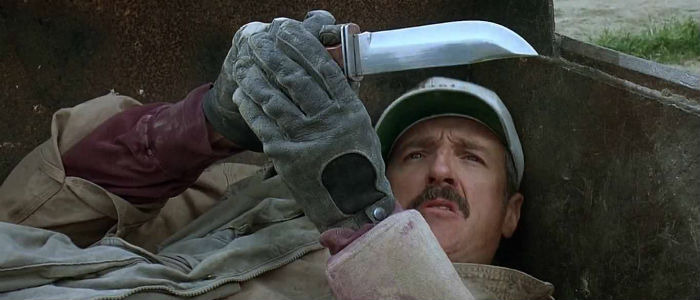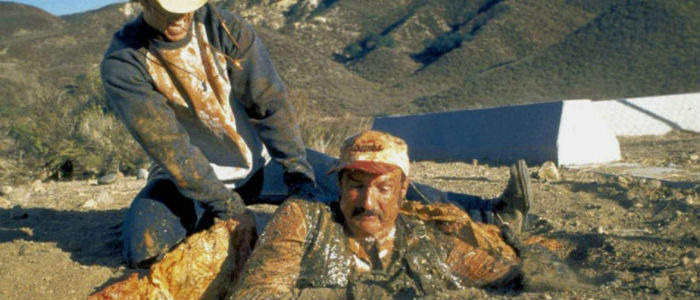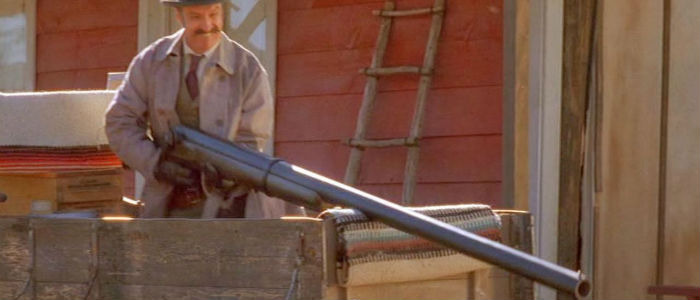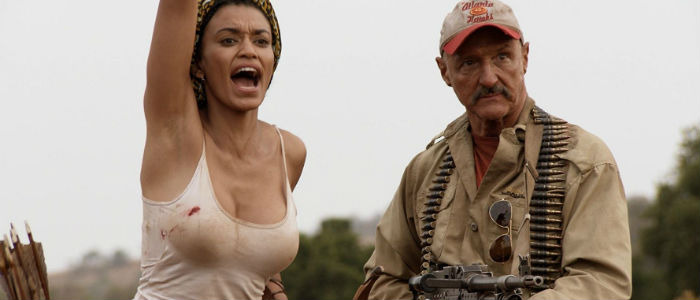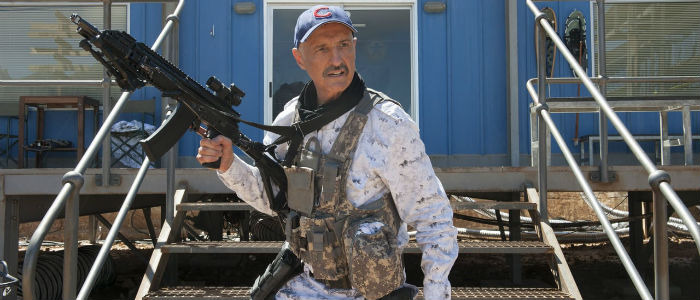The 'Tremors' Franchise Is Now Six Films Deep, So Of Course We Watched Them All
(Welcome to DTV Descent, a series where we explore the weird and wild world of direct-to-video sequels to theatrically released movies. In this edition we dig deep on the five – five! – DTV sequels to the terrifically fun and eminently rewatchable Tremors.)
1990's Tremors is something of a rare bird. It's a creature feature that appeals to all kinds of moviegoers as it delivers monster mayhem alongside personality, laughs, and charm. Even more important and impressive? It does it with some fantastic and original practical effects. Big worms, sharp beaks, long tongues... when they blow up it results in big smiles and a rainstorm of sloppy wet guts. It was a modest hit in theaters, but it's become a beloved modern classic over the years as more people discover it and the rest of us continue to re-watch it.
Sequels seemed like a no-brainer, but it took six years for the first one to appear – straight to video, naturally – and four more have plopped onto DVD in the more than 20 years since. The bigger surprise than their actual existence is the realization that they're not all as bad as you'd fear. I know, I was surprised too. That said, I used the word "plopped" for a reason. Unmemorable scripts, bland characters, and the advent of cheap, ugly CG mark the franchise as a series of frequently diminishing returns despite holding the odd claim of being an action/horror franchise headlined by Family Ties' Michael Gross. The hope that the once upcoming (but newly canceled) TV series from Blumhouse would bring back the magic along with stars Kevin Bacon and Fred Ward is no more, so we'll have to settle for a look at the five DTV sequels to Tremors.
The Beginning
Tremors focuses on the barely-there town of Perfection, Nevada and its two handymen, Earl (Ward) and Valentine (Bacon). They're best friends and roommates, and when a septic line spews fecal matter in their faces they decide to call it quits on desert life. They don't get far, though, as some monstrous grubs they name Graboids have arrived from parts unknown with a hankering for meat – human or otherwise. With the only road out of town blocked and communications down, Earl, Val, and the rest of Perfection's single-digit population, including gun-nut Burt Gummer (Gross), are forced to fight for their lives. It's a fight not everyone will win.
The DTV Plot
All five sequels follow the same "big picture" plot as new Graboids (or variations thereof) pop up somewhere in the world, causing havoc and requiring extermination. The differences between the stories come down mostly to location and characters.
Tremors 2: Aftershocks (1996) sees our heroes having gone their separate ways. Val is long gone, having married the first film's spunky geologist Rhonda and moved away – Bacon was no fan of the first film and expressed dismay that he had even signed on, so his absence here is expected – but Earl parlayed his brief fling with fame and fortune into an ostrich farm. It's not quite paying the dividends he'd hoped, though, so when a visitor from Mexico offers to pay good money for him to come down and fix their own Graboid problem he says a reluctant yes. It's all pretty straightforward until Earl realizes there's something new on the desert horizon in the form of Shriekers.Tremors 3: Back to Perfection (2001) returns the franchise back to where it began with the still-small town of Perfection. It's become something of a minor tourist destination since the first film's onslaught, but while the locals play visitors for rubes with rigged tours, the fun comes to an end when the creatures decide to return too. Most of the first film's survivors – the ones whose names you don't know – are still living in town, and Burt once again has to step up to shut down the invasion with all the weapons at his disposal. He's gonna need all the help he can get as the Shriekers are now transforming into something new. That's right. We've got Ass-Blasters.Tremors 4: The Legend Begins (2004) is set in 1889 and the not-quite town of Rejection, NV. Their sole source of income is a local silver mine, but when Graboids slaughter most of the mining crew, the already small town empties out beyond a handful of die-hard residents. The mine's owner arrives while the others leave, and Hiram Gummer – what, you thought a film set more than a century in the past wouldn't have a role for Michael "I have my own horror franchise" Gross?! – is not happy to see his mine shut down. He hates weapons (get it?!) and hires a gunman (Billy Drago) to kill the beasts, but when push comes to shove he's forced to step and save the mine and the town with his new appreciation of firepower.Tremors 5: Bloodline (2015) sees the creatures making their first appearance on another continent (this despite a hunt previously mentioned in Argentina) as they start feasting on people in rural South Africa. Bert accepts the invite of a shady government representative, and with his new cameraman Travis (Jamie Kennedy) in tow, they head to the cradle of civilization to do some hunting. It's a whole new world as the throat tendrils are now detachable, the Graboids are bigger than ever, Bert discovers he's a father, and it may have taken a visit to Africa, but the Tremors franchise finally has black characters. (Not stirring up s*** here, just think it's crazy there isn't a single black character in the previous four films.)Tremors: A Cold Day in Hell (2018) once again finds Bert scraping by financially, this time as proprietor of Chang's Market. He and his son Travis get a call from scientists in the Canadian Arctic after an apparent Graboid attack kills three of their team members, and before you can say "Michael Gross seriously has his own horror franchise?", the Gummer family is on a plane heading to the great white north. (Well, South Africa again actually as they apparently have some great tax deals for low budget filmmakers.) They find the expected monsters, but two revelations put a crimp in their plans – government agents may be weaponizing the creatures, and Bert discovers his time in the belly of the beast (he was swallowed whole in the third film) has left him poisoned and nearing death's door. Oh, and Val's daughter is here too.
Talent Shift
Tremors is no high profile Hollywood affair, but not even a bigger budget could have netted them a more perfect lead pairing than Kevin Bacon and Fred Ward. As mentioned above, Bacon was no fan of the film at the time (although he's come around considerably in the years since), but unlike some actors incapable of hiding their career disdain (I'm looking at you Bruce Willis), he gives a fully invested performance roaring with energy and attitude. Ward is his senior, but keeps pace beat for beat, and together they create an incredibly likable and charismatic duo whose banter is built on friendship, respect, and decision-making rounds of Rock-Paper-Scissors. The supporting cast is a mix of faces both new and familiar with Michael Gross, Reba McEntire, and the great Victor Wong filling out the latter.
Director Ron Underwood, meanwhile, made his feature debut here before moving on to recognizable comedy gems including City Slickers (1991) and Heart and Souls (1993), and writers S.S. Wilson and Brent Maddock followed with him for part of that ride. They came into this project, though, with solid experience in the area of genre comedies having previously written the beloved Short Circuit (1986) and *batteries not included (1987).
The sequels have very little of that already limited cachet.
Ward sticks around for the first sequel, but he's missing a balance as, in lieu of Bacon, he's saddled with Chris Gartin. No disrespect to Mr. Gartin, but he lacks Bacon's sizzle. (No I won't apologize for that.) The remaining sequels all shift Gross into the role of leading man, but it's nowhere near as effective as having a real one. This isn't a knock on Gross' performance – it's all about the character. Burt Gummer is a caricature, and as perfectly as he (and McEntire's Heather Gummer) works in the first couple of films, it's due as much to the character's brevity as to the performance and/or writing. Bert is designed to be ingested in small doses, and bumping him up to a lead role would be like a Scream movie built entirely around Randy. He's not the draw, the character can quickly grow annoying, and he doesn't have the charisma to carry a film.
This feels like a good opportunity to point out that Bloodlines and A Cold Day in Hell give Bert a sidekick in the form of a thrill-seeking, ex-NSA agent named Travis B. Welker.
And he's played by Jamie Kennedy.
How the Sequels Respect the Original
In addition to featuring the obvious link – big earthy monsters terrorizing rural communities – the sequels at least try to recapture the cantankerous banter between the first film's leads. ("Try" being the operative word.) The films manage some laughs between them (albeit fewer combined between them than in the first movie). They also aim for a constant stream of new creature creations – the addition of Shriekers, Ass-Blasters, and other variations means there's often some new beastie on the horizon.
Most of the sequels are surprisingly passable fare, but there's little that stands out to really recommend them. In the interest of positivity, though, and in recognition that they're not all as bad as DTV sequels tend to be, there are a couple things worth highlighting. The first film's use of practical creature design (along with optical FX) is continued through Aftershocks, which sees the majority of its effects work exist in the practical world. Just as noteworthy, Bloodlines and A Cold Day in Hell both bring blood into the Tremors world for the first time in any substantial way. They're still primarily focused on comedy, but each of these last two feature fairly harrowing attacks that almost rival the intensity of poor Walter's demise in the floor boards of his shop in the first film.
How the Sequels S*** on the Original
Typically, this is the section where I get to go off on the DTV sequel(s) in question with gleeful abandon, but this time I'm stuck less with abominations and more with cookie-cutter mediocrity. The biggest complaint to lobby against the sequels is in the area of effects. A lack of star power can easily be forgiven when there's something fun worth watching, but starting with Back to Perfection, the films become overrun with generic CG effects. Close-ups sometimes revert back to practical creations, but far too much of the onscreen creature action is CG. And we're not talking Jurassic Park-level, ILM-quality magic here folks. The CG creatures lack a tangible presence which in turn leaves them feeling more like cartoons than threats.
The Legend Begins deserves some more specific scorn, though, as it feels like a minimal effort made on half a whim. I imagine it was born on the simple premise of "what if Bert Gummer's great grandfather didn't like guns?!" Hilarity ensues. Unfortunately, while NRA-member Gummer earns minimal laughs as a spoof, he's an empty vessel without that parodiable shell. Very little thought went into the story too, and the budget followed suit. The town of Rejection makes Perfection look like a bustling metropolis, and the handful of buildings are literally front walls only – everything beyond each building's street-facing facade is a tent. A tent! So where'd the money go? It certainly wasn't to the effects department or set dresser. It definitely wasn't to the casting – unless Billy Drago was in far higher demand 14 years ago than any of us suspected.
Conclusion
Look, do I recommend watching all five (so far) of the DTV Tremors sequels? I do not. On the flip side, though, the only one I'd actively advise you skip is The Legend Begins. It's so dull and so very cheap. The others are harmless creature features offering a handful of laughs, some minor thrills, and more than a few gut-filled showers. None come close to the charm of the original, but if you're craving a fix that only Michael Gross can supply, you should look into the psychology of that... and then look no further than this unlikeliest of horror franchises.

